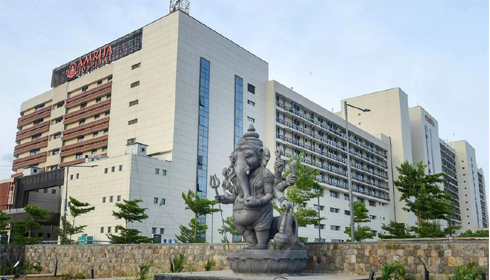
Amrita Hospital doctors perform World’s First Robot-Assisted Surgery for Rare Colonic Tumour Successfully
A 67-year-old Uzbek man had the world's first robot-assisted surgery for a rare colonic tumour at Amrita Hospital in Faridabad, marking a significant medical milestone. This pioneering surgery not only saved his life but also established a new standard in medical technology.
The patient, who had a rare condition where his liver and colon were in strange places (known as situs inversus partial), developed a malignant tumour in his misplaced colon. The tumour was blocking his large intestine, preventing him from eating solid foods, and threatening to spread further. Dr. Abhishek Agrawal and his colleagues led the six-hour surgery, which included Prof. Puneet Dhar and Dr. Saleem Naik from Amrita Hospital's Department of Gastrointestinal Surgery.
"Robot-assisted surgery significantly enhances precision and accuracy during procedures," according to Dr. Agrawal. Dr. Agrawal added that a specialised console, which displays a high-resolution 3D picture of the operating area for enhanced depth perception and detailed graphics, carried out the surgery. The robotic devices can bend and spin with greater precision than a human hand, allowing for more complex actions. Furthermore, the system filters out any natural hand tremors, resulting in more stable and controlled actions. "These capabilities contribute to more accurate targeting and removal of tumours, preservation of healthy tissues, and overall improved surgical outcomes," says Dr. Agrawal.
Situs inversus partial, a rare condition where some internal organs mirror, affects approximately one in every 10,000 individuals. This disorder frequently leads to misdiagnosis and delayed treatment of major health problems. The unusual positioning of this patient's organs made surgery particularly challenging.
Dr. Puneet Dhar noted that the surgery was particularly tough due to the patient's unique anatomy. To properly access and remove the tumour, we needed to alter both the patient's position and the robotic equipment. Despite these hurdles, the patient's operation and rehabilitation went well. The day after the surgery, they transferred him to a general ward, and on the third day, he resumed normal eating. About a week later, the hospital released him.
Dr. Saleem Naik added, "Based on the final biopsy report, the patient will require chemotherapy. After treatment, he will just require frequent check-ups to ensure that the tumour does not recur. He can live a regular life free of long-term drugs and constraints.
The tumour had caused an intestinal blockage in the patient for two months, leading to significant weight loss and an inability to eat. His symptoms included vomiting, weight loss, anaemia, and abdominal swelling, which prompted him to visit the hospital.
The patient expressed his gratitude, saying, "I am extremely grateful to the team at Amrita Hospital for their exceptional care." Not only did the robot-assisted surgery cure my problems, but it also considerably enhanced my quality of life. I can again eat regularly and live without the continual pain and anguish I was feeling."
Robot-assisted surgery has numerous advantages, including shorter hospital stays, faster recovery, smaller incisions, less discomfort, and a reduced risk of infection. The improved precision of the robots enables effective and targeted operations, resulting in faster healing. Safety precautions include extensive physician training, multiple system checks, and constant monitoring of both the patient and the robot throughout surgery. Surgeons have complete control over the equipment and can override the system as needed, providing dependable and effective therapy.
This successful surgery at Amrita Hospital demonstrates the potential of robotic technology to revolutionise complex medical procedures, providing new hope to patients with difficult diseases.